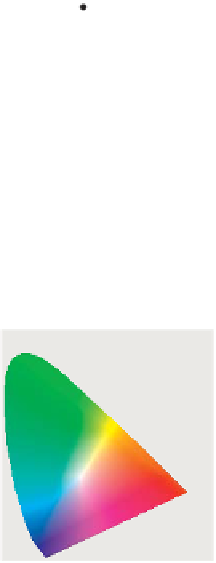Graphics Reference
In-Depth Information
x
=
y
=
z
=
1
/
3, although it is close. (Other reference whites are described
in Section 28.11.)
Note that if we know
x
and
y
, we can compute
z
=
1
(
x
+
y
)
, but this does
not allow us to recover
X
,
Y
, and
Z
; for that we need at least one more piece of
information (all
xyz
-triples lie on a planar subspace of
XYZ
-space). Typically we
recover
XYZ
from
x
,
y
, and
Y
(the luminance value). The formulas are
−
X
=
x
y
Y
,
(28.27)
Y
=
Y
, and
(28.28)
Z
=
1
−
(
x
+
y
)
y
Y
.
(28.29)
y
The chromaticity diagram has several applications.
First, we can use the diagram to define
complementary colors:
Colors are
complementary if they can be combined to form illuminant
C
(e.g.,
D
and
F
in
Figure 28.19). If one requires a half-and-half mix in the definition, then some
colors, like
B
, have no complement.
0.9
520
0.8
540
510
0.7
B
560
0.6
500
580
A
0.5
0.4
D
600
Second, the diagram lets us make precise our notion of
excitation purity:
A color like the one indicated by point
A
in Figure 28.18 can be represented
by combining illuminant
C
with the pure-spectral color
B
. The closer
A
is to
B
, the more spectrally pure it is. So we can define the excitation purity to be
the ratio of the length
AC
to the length
BC
. We extend this definition to
C
by
saying that its excitation purity is zero. For some colors, like
F
, the ray from
C
through
F
meets the boundary of the horseshoe at a nonspectral point; such col-
ors are called
nonspectral;
but the ratio
CF
to
CG
still makes sense, and we
can define excitation purity this way. The dominant wavelength, however, is more
problematic; the standard is to say that the dominant wavelength is a “comple-
mentary” one at
B
, which would be denoted 555 nm c, where the “c” indicates
complementarity.
A third use of the chromaticity diagram is the indication of
gamuts:
Any light-
producing device (like an LCD monitor) can produce a range of colors that can be
indicated on the chromaticity diagram. Colors outside this gamut cannot be pro-
duced by the device. (Similarly, printing devices have gamuts, once one defines a
standard illuminant under which the printed page will be viewed.) A device that
can produce two colors can also produce (by adjusting the amounts of each) chro-
maticity values that are convex combinations of the two. In Figure 28.20, lights
whose chromaticity values are
I
and
J
can be combined to form chromaticity
values on the line segment between them; adding a third color
K
gives a gamut
consisting of a whole triangle. Clearly there's no triangle with vertices in the
horseshoe that contains the entire horseshoe; thus, no three-color display, no mat-
ter how perfectly calibrated, can produce all color percepts.
0.3
490
C
700
E
0.2
F
4
80
0.1
0.0
400
G
x
0.0
0.1
0.2
0.3
0.4
0.5
0.6
0.7
0.8
Figure 28.19: Colors on the chro-
maticity diagram. D and E are
complementary.
y
0.9
520
0.8
540
510
0.7
560
0.6
I
500
580
0.5
0.4
600
0.3
490
700
J
K
0.2
480
0.1
0.0
400
x
0.0
0.1
0.2
0.3
0.4
0.5
0.6
0.7
0.8
Figure 28.20: Mixing of colors in
the chromaticity diagram. Colors
on the line IJ can be created by
mixing the colors I and J; all col-
ors in the triangle IJK can be
created by mixing the colors I
,
J
,
and K.
Note that printer gamuts are typically far smaller than those of displays; in
high-end printers, this can be partially remedied by the use of
spot color
—
additional inks placed in the printer to expand the gamut so as to include a partic-
ular color. But in general, getting faithful print versions of images from a display
is impossible. The problem of gamut matching (i.e., finding reasonable mappings
from the gamut of one device to that of another) remains a serious challenge.

























































































































































